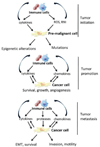Inflammation and oncogenesis: a vicious connection
- PMID: 20036794
- PMCID: PMC2821983
- DOI: 10.1016/j.gde.2009.11.004
Inflammation and oncogenesis: a vicious connection
Abstract
Epidemiological and experimental data suggest a close connection between inflammation and tumorigenesis. Solid tumors are typically infiltrated with immune cells and inflammation impacts most, if not all, stages of tumorigenesis. Molecular and cellular pathways, which connect inflammation and cancer, have emerged as attractive targets for prevention and therapy. In this review we discuss general mechanisms and concepts of cancer promoting inflammation.
Copyright 2009 Elsevier Ltd. All rights reserved.
Figures

Similar articles
-
Differential expression of miRNAs regulating NF-κB and STAT3 crosstalk during colitis-associated tumorigenesis.Mol Cell Probes. 2019 Oct;47:101442. doi: 10.1016/j.mcp.2019.101442. Epub 2019 Aug 31. Mol Cell Probes. 2019. PMID: 31479716
-
Rafoxanide negatively modulates STAT3 and NF-κB activity and inflammation-associated colon tumorigenesis.Cancer Sci. 2024 Nov;115(11):3596-3611. doi: 10.1111/cas.16317. Epub 2024 Sep 6. Cancer Sci. 2024. PMID: 39239848 Free PMC article.
-
The Role of Proinflammatory Pathways in the Pathogenesis of Colitis-Associated Colorectal Cancer.Mediators Inflamm. 2017;2017:5126048. doi: 10.1155/2017/5126048. Epub 2017 Aug 9. Mediators Inflamm. 2017. PMID: 28852270 Free PMC article. Review.
-
NF-kappaB and cancer-identifying targets and mechanisms.Curr Opin Genet Dev. 2008 Feb;18(1):19-26. doi: 10.1016/j.gde.2008.01.020. Epub 2008 Apr 24. Curr Opin Genet Dev. 2008. PMID: 18440219 Free PMC article. Review.
-
NF-κB and STAT3 signaling pathways collaboratively link inflammation to cancer.Protein Cell. 2013 Mar;4(3):176-85. doi: 10.1007/s13238-013-2084-3. Epub 2013 Mar 13. Protein Cell. 2013. PMID: 23483479 Free PMC article. Review.
Cited by
-
Inflammation and oxidative stress in angiogenesis and vascular disease.J Mol Med (Berl). 2013 Mar;91(3):323-8. doi: 10.1007/s00109-013-1007-3. Epub 2013 Feb 22. J Mol Med (Berl). 2013. PMID: 23430240 Free PMC article. Review.
-
From inflammaging to healthy aging by dietary lifestyle choices: is epigenetics the key to personalized nutrition?Clin Epigenetics. 2015 Mar 25;7(1):33. doi: 10.1186/s13148-015-0068-2. eCollection 2015. Clin Epigenetics. 2015. PMID: 25861393 Free PMC article.
-
A multi-targeted approach to suppress tumor-promoting inflammation.Semin Cancer Biol. 2015 Dec;35 Suppl:S151-S184. doi: 10.1016/j.semcancer.2015.03.006. Epub 2015 May 5. Semin Cancer Biol. 2015. PMID: 25951989 Free PMC article. Review.
-
RNase-L deficiency exacerbates experimental colitis and colitis-associated cancer.Inflamm Bowel Dis. 2013 May;19(6):1295-305. doi: 10.1097/MIB.0b013e318281f2fd. Inflamm Bowel Dis. 2013. PMID: 23567782 Free PMC article.
-
A Phenylacetamide Resveratrol Derivative Exerts Inhibitory Effects on Breast Cancer Cell Growth.Int J Mol Sci. 2021 May 17;22(10):5255. doi: 10.3390/ijms22105255. Int J Mol Sci. 2021. PMID: 34067547 Free PMC article.
References
-
-
Dunn GP, Old LJ, Schreiber RD. The immunobiology of cancer immunosurveillance and immunoediting. Immunity. 2004;21:137–148. (** Seminal review which discusses in details tumor immunosurveillance and tumor immune escape)
-
-
- Dunn GP, Old LJ, Schreiber RD. The three Es of cancer immunoediting. Annu Rev Immunol. 2004;22:329–360. - PubMed
-
-
Koebel CM, Vermi W, Swann JB, Zerafa N, Rodig SJ, Old LJ, Smyth MJ, Schreiber RD. Adaptive immunity maintains occult cancer in an equilibrium state. Nature. 2007;450:903–907. (** This paper provides unequivocal evidence for the existence of the equilibrium between tumor and immune system in vivo)
-
-
- Bui JD, Schreiber RD. Cancer immunosurveillance, immunoediting and inflammation: independent or interdependent processes? Curr Opin Immunol. 2007;19:203–208. - PubMed
Publication types
MeSH terms
Substances
Grants and funding
LinkOut - more resources
Full Text Sources
Other Literature Sources

